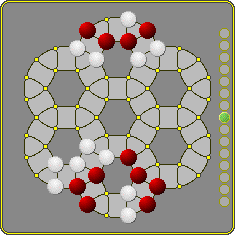 | Lotus is Medusa's support act.
|
- If a player passes his turn, he moves the marker one point towards him. The player at whose side the marker is at the end of the game, receives the corresponding number of points in addition to the points he has on the board.
- A group consists of a single stone or several connected stones of the same color. The liberties of a group are the adjacent vacant points. The stones in a group share the group's liberties.
- A group lives unconditionally if it contains a lotus - six stones around one of the boards seven hexagons. A group without a lotus lives as long as it has at least one liberty.
Capture
Assuming none of the groups involved is protected by a lotus, a move may result in:
 |
|
The two vacant points at the bottom are neutral, unless one of the players moves there. However, in that case the other can capture the thus extended group, so this is a seki.
Object and counting
- The game ends by one player's resignation or if both pass completely on successive turns. In the latter case dead stones are reversed.
- The winner is now the player with the most territory.
Territory consists of a player's number of stones on the board plus the number of cells totally surrounded by his stones
The player whose side it is on also adds the number of points indicated by the marker. - Seki may occur: empty points not totally surrounded by either player count for neither.
Lotus and its ancestor Medusa are featured in R. Wayne Schmittberger's 'New Rules for Classic Games' (John Wiley & Sons, Inc. New York; ISBN 0-471-53621-0).
How I invented ... Lotus
External links
Lotus © MindSports
